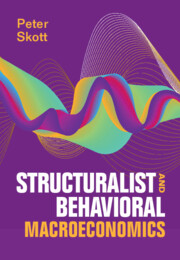Book contents
- Frontmatter
- Contents
- Figures
- Preface and Acknowledgments
- 1 Introduction: The State of Macroeconomics
- 2 The Lucas Critique and Representative Agents
- 3 Household Consumption and Saving
- 4 Saving in a Corporate Economy
- 5 Phillips Curves and the Natural Rate of Unemployment
- 6 Fairness, Money Illusion, and Path Dependency
- 7 Earnings Inequality, Power Bias, and Mismatch
- 8 Macroeconomic Adjustment and Keynes’s Instability Argument
- 9 Growth and Cycles
- 10 Endogenous Growth Cycles with or without Price Flexibility
- 11 Secular Stagnation and Functional Finance
- 12 Concluding Comments: Evidence-Based Macroeconomics and Economic Theory
- References
- Author Index
- Subject Index
5 - Phillips Curves and the Natural Rate of Unemployment
Published online by Cambridge University Press: 10 November 2023
- Frontmatter
- Contents
- Figures
- Preface and Acknowledgments
- 1 Introduction: The State of Macroeconomics
- 2 The Lucas Critique and Representative Agents
- 3 Household Consumption and Saving
- 4 Saving in a Corporate Economy
- 5 Phillips Curves and the Natural Rate of Unemployment
- 6 Fairness, Money Illusion, and Path Dependency
- 7 Earnings Inequality, Power Bias, and Mismatch
- 8 Macroeconomic Adjustment and Keynes’s Instability Argument
- 9 Growth and Cycles
- 10 Endogenous Growth Cycles with or without Price Flexibility
- 11 Secular Stagnation and Functional Finance
- 12 Concluding Comments: Evidence-Based Macroeconomics and Economic Theory
- References
- Author Index
- Subject Index
Summary
The existence of a ‘natural rate of unemployment’ informs much of economic policy. But attempts to explain large cross-country differences and time-series changes in unemployment are unconvincing, and strong prior beliefs are required to interpret the evidence as supportive of the natural rate hypothesis. And the natural-rate hypothesis is also fragile on theoretical grounds. Stylized policy games between monetary policymakers and the private sector have suggested that discretionary policy regimes suffer from inflationary bias and that policy makers cannot achieve sustained reductions of unemployment below the natural rate. The results are radically different in the presence of labor unions, even with perfect foresight and well-defined preferences over inflation and output: a central bank that is completely indifferent to the level of inflation may obtain outcomes with high employment and zero inflation, while inflation-averse central banks generate stagflation with positive inflation and low employment. The reduced-form relation between unemployment and inflation following a shift in the central bank’s objective function can be negative or positive, depending on details.
Keywords
- Type
- Chapter
- Information
- Structuralist and Behavioral Macroeconomics , pp. 102 - 130Publisher: Cambridge University PressPrint publication year: 2023

